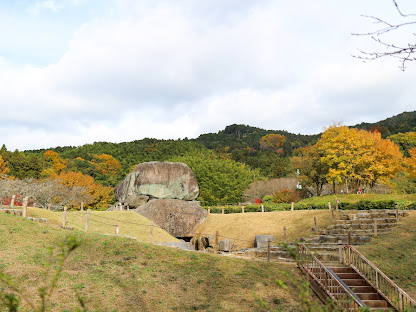When people hear “Nara”, more often than not the first and only image that comes up are the famous deer at Nara Park in Nara city. But there is so much more to Nara, and in my 3-day trip I’ve discovered the historical and environmental significance of this prefecture. With more than 3/4 of Nara being mountainous, the nature provides an ideal climate for all kinds of vegetation, especially persimmons which I had the pleasure to pick from a local farm this time.
In this deep dive into Nara prefecture, we will be covering Asuka Village, Gojo City, and Totsukawa Village. There is a mixture of historical, cultural, and the taste of Nara. I wish I could share with you how fresh the air smelled, crisp with a hint of the mountains and crops around. But that’s something you’ll have to experience for yourself in person.
Asuka Village’s Origins
The humble village Asuka 明日香村 of about 5,000 inhabitants is on the southeast side of Yamato-Yagi Station (Kintetsu Osaka Line). It holds significance as being where the ancient Asuka period (飛鳥時代, year 538-710) palaces were located. On top of that, there are also many large-scale tombs found here, also known as Kofun.
The Rice Terraces of Inabuchi
Our first stop on this journey is the beautiful Rice Terraces of Inabuchi 稲渕の棚田. It is a part of the Nara Prefecture landscape asset, with beautiful yellow Nanohana blooming in spring, fireflies in Summer, and Red Spider Lilies or Higanbana in Autumn. When the Red Spider Lilies bloom in September, they also have a scarecrow contest. The creativity is wonderful to see. Even if you don’t have a chance to visit in September, there is also a display board of all the scarecrows of the year on the side of the row for you to see.
In the distance, the rice fields are framed with beautiful mountain ranges. We went towards the end of November so it was peak Autumn foliage season. Unlike Kyoto’s fiery red Momiji leaves, Nara’s foliage is a warm and welcoming soft orange color. Every mountain and valley you see while driving through Nara is filled with this orange color.
Lunch at Oku Asuka Sarara
This cozy little restaurant will celebrate its 15th anniversary this year in 2023. It’s run by just 2 staff, including the owner who is a lady in her 40-50s who is also an amazing cook. She started this restaurant after buying this traditional Japanese house. Walking in feels like you are in your own home, with handmade tapestry on the wall and all kinds of embroidery art. Even the coasters for the tea cups are handmade.
Lunch is a set menu, carefully designed to incorporate fresh seasonal produce from Nara. From black rice produced in Oku Asuka, to mushrooms and other vegetables grown right in their backyard, the meal was a very well-balanced and healthy meal. The seasoning was light and complimentary, which let the ingredients themselves stand out as the main taste. It was really refreshing, especially coming from a big city like Tokyo where lots of oil, preservatives, or MSG is used in food prep.
After the delightful meal, we were given a tour of the Inn just next door. It’s a spacious and comfortable house suitable for group meetings or a relaxing farm stay. Due to the spread of the new coronavirus infection, the owner is currently suspending lodging acceptance. It’s currently still completing its finishing preparations to be opened for stays, so please stay tuned and in the meantime, enjoy their amazing restaurant.
*The restaurant requires reservations 1 day in advance as spots are limited. Please call 0744-54-5005.
Visiting the magnificent tomb of Ishibutai Tumulus
The grand finale of Asuka Village is the Special Historical Site of Ishibutai Kofun. The world Ishibutai literally translates to “stone stage”. Because tumulus are large stones covering the ceiling of the burial chamber, it looks like a large platform stage. It’s believed that performances area actually given on this stage.
This site dates back to year 626 where “Soga-no-Umako” was buried here, who’s family was one of the most powerful ancient families of Japan at the time. You can go inside the incredible structure, with the inner chamber being 7.5m long and 3.4m wide, and 4.8m high. It’s built from 30 stones and the largest piece weights 77 tons. Surrounding the four sides is a moat lined with maple leaves in autumn and cherry blossoms in spring.
Part 2: Gojo City
From Asuka village, we continue to Gojo city. Its highlight being persimmon picking, which is one of my favorite activities from this entire trip.
Please continue reading the next blog post to learn more about Gojo City.
Follow me on Instagram @ariel.land for more Japan guides

















My father plans to enjoy cherry blossoms nyc. He asked me the best place I recommend My father you go the be Nara Japanese prefecture. this is the best place to in Japan.
ReplyDelete